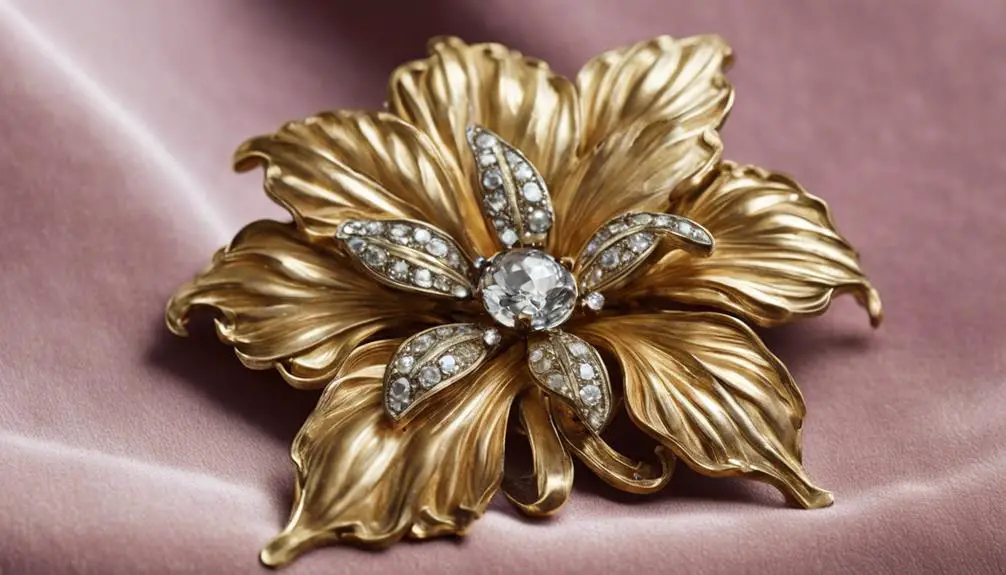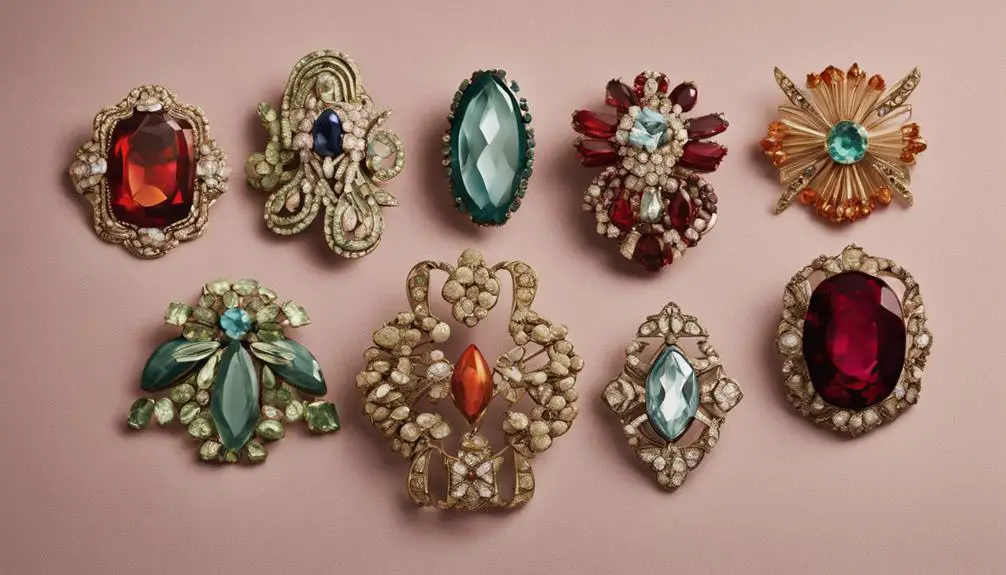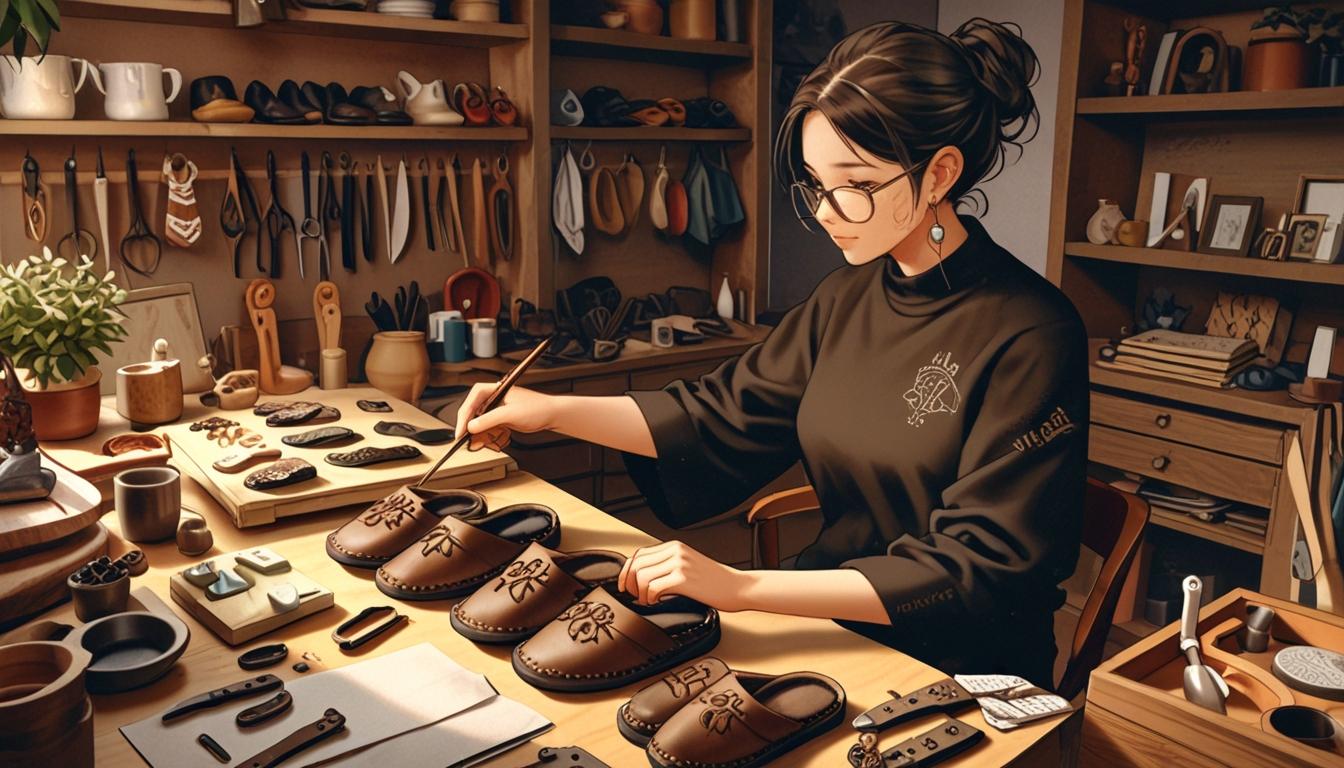In the 1940s, women's brooches became essential fashion pieces amid wartime restrictions. You'd find decorative designs transforming simple attire into expressions of creativity. Influenced by Art Deco, these brooches often featured floral motifs and bold geometric shapes. Iconic designers like Trifari and Cartier crafted pieces from sterling silver, gold plate, and vibrant enamel. These ornaments not only added elegance but also reflected women's growing agency and resourcefulness during tough times. Larger and more ornate styles stood out against utilitarian clothing, making strong personal statements. There's much more to uncover about these fascinating ornaments and their lasting impact.
Historical Significance of 1940s Brooches

In the 1940s, brooches emerged as a crucial element of women's fashion, serving not just as accessories but as powerful symbols of personal expression during a time of wartime austerity. As clothing became simpler and more utilitarian due to fabric rations, these ornamental pieces provided a decorative contrast, allowing women to showcase their individuality. The crafting of vintage clothing during this era often involved unique designs, making brooches a distinctive addition that reflected the high-quality craftsmanship of the time, as seen in vintage clothing labels.
The era's brooches often featured intricate designs, with floral motifs particularly popular. A sterling silver floral brooch, for instance, could transform a plain dress into a statement of elegance and femininity. Renowned designers like Trifari, Mazer, and Cartier created iconic pieces that reflected the prevailing Art Deco and Retro Modern styles, making the brooch not only a fashion accessory but also a collectible treasure.
Moreover, the shift from geometric forms to asymmetrical and three-dimensional designs mirrored evolving societal norms and fashion trends. This evolution signified more than just aesthetics; it represented women's growing agency and self-expression during a turbulent time. Consequently, the historical significance of 1940s brooches lies in their dual role as both adornments and affirmations of identity, capturing the spirit of an era marked by resilience and creativity.
Popular Materials and Designs
The materials and designs of 1940s brooches reflect a unique blend of artistry and practicality that defined women's fashion during this era. Sterling silver emerged as a popular choice, offering a timeless elegance that complemented the bold styles of the time. Many brooches featured a mix of gold plate and gilt metal, often embellished with vibrant enamel and exquisite gemstones like diamonds, rubies, and turquoise, adding a touch of luxury.
The design aesthetic was heavily influenced by Art Deco, showcasing bold geometric shapes and intricate craftsmanship. You'd likely find whimsical floral motifs, with flower brooches being particularly popular, as they captured the essence of nature while aligning with the era's artistic trends. This nature-inspired theme resonated with women seeking a connection to beauty and individuality in their accessories.
Additionally, the use of both natural and synthetic materials allowed for diverse choices, appealing to various fashion sensibilities. Signature pieces from renowned designers like Trifari and Mazer not only enhanced the collectible value but also marked a shift towards more personalized and expression-driven jewelry. Overall, the brooches of the 1940s were a reflection of the era's creativity and resourcefulness.
Iconic Designers and Their Creations

Brooches from the 1940s stand out not just for their materials and designs but also for the visionary designers behind them. Iconic names like Trifari, Mazer, and Alfred Philippe crafted unique pieces that showcased intricate artistry and high-quality materials, including gold plated and sterling silver elements. For instance, Trifari's Retro Sterling Vermeil Jeweled Key Brooch exemplifies the brand's exceptional craftsmanship, marked with a signature that adds to its collectibility.
European designers also made their mark during this decade, introducing exquisite creations such as Late Deco French flower brooches and the Collectible Line Vautrin Gilt Bronze Brooch. These pieces reflect the era's artistic movements and a commitment to craftsmanship. Renowned houses like Cartier and Van Cleef & Arpels produced iconic brooches, with Cartier's 18 KT Yellow Gold Onyx Diamonds Flower Brooch epitomizing luxurious elegance.
The unique designs of these 1940s brooches often featured nature-inspired motifs and geometric shapes, influencing future jewelry trends. Each brooch serves as a manifestation of the creativity and innovation of these designers, making them treasured artifacts in the world of fashion and jewelry.
Brooches as Fashion Statements
During the 1940s, women embraced brooches as essential fashion statements, transforming simple wartime attire into expressions of individuality and style. Brooches were often strategically placed on shoulders or at necklines, enhancing the otherwise austere clothing typical of the time. The era's brooch designs ranged from elegant floral motifs to bold geometric shapes, with whimsical themes reflecting the evolving societal norms.
Notable pieces, such as the rose brooch, became symbols of both beauty and resilience, offering a splash of color and personality against muted fabrics. The popularity of larger, ornate designs allowed women to showcase their unique styles, even amidst the constraints of wartime fashion. Brooch pins, crafted from luxurious materials like sterling silver and gold plate, served not just as accessories but as statements of elegance and self-expression.
Safety pins, initially practical, also found their place in this trend, often reimagined into stylish adornments that conveyed a sense of resourcefulness. Consequently, brooches during the 1940s epitomized more than mere accessories; they were essential tools for women to assert their individuality in a challenging era.
Collecting Vintage Brooches Today

Collecting vintage brooches today offers enthusiasts a fascinating glimpse into the artistry and culture of the 1940s. As you immerse yourself in this vibrant market, you'll discover unique designs that showcase the craftsmanship of renowned brands like Trifari and Mazer. These pieces, often featuring signature markings, not only elevate authenticity but also enhance their value—especially if you find a sterling fan or a whimsical Dog pin. Understanding the importance of vintage tag identification can further deepen your appreciation for these beautiful accessories.
The resurgence in interest has driven prices from $25 to $495, reflecting rarity and condition. You'll notice collectors gravitate towards materials characteristic of the era, such as gold plate, sterling silver, and stunning gemstones like aquamarine and citrine. Each pin you encounter tells a story, connecting you to a historical narrative that resonates with the fashion of the time.
Online platforms and vintage fairs present ample opportunities to explore diverse selections, making it easier than ever to add pieces to your collection. With options for free shipping, you can enjoy the thrill of acquiring these beautiful brooches without breaking the bank. As you collect, you'll not only curate a collection but also preserve a slice of history that embodies the spirit of the 1940s.
Frequently Asked Questions
What Jewelry Was Popular in the 1940s?
In the 1940s, jewelry showcased bold designs and intricate craftsmanship. You'd find gold plating, vibrant gemstones, and unique shapes, reflecting personal expression and societal norms, making each piece a meaningful accessory in wartime fashion.
How Do You Identify Vintage Brooches?
To identify vintage brooches, you'll want to look for designer signatures, examine materials, check construction quality, and observe design elements. Signs of age and wear can also help confirm authenticity and value.
What Are the Four Types of Brooches?
You'll find four main types of brooches: pin brooches with clasps, clip brooches for bold statements, duette brooches combining pieces, and whimsical scatter pins designed for playful layering. Each offers unique styling options.
What Year Were Brooches Popular?
Brooches experienced significant popularity during the 1940s, largely due to their ability to enhance simple outfits. You'll find that their bold designs and intricate craftsmanship made them essential accessories for expressing personal style in that era.




